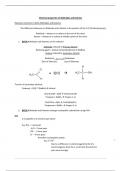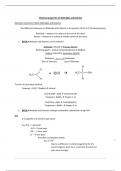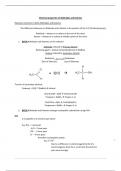Carbon nucleophiles Study guides, Class notes & Summaries
Looking for the best study guides, study notes and summaries about Carbon nucleophiles? On this page you'll find 72 study documents about Carbon nucleophiles.
Page 3 out of 72 results
Sort by

-
AQA A Level Chemistry 2022 Paper 2 SOLUTION 2023//2024
- Exam (elaborations) • 5 pages • 2023
-
- $9.99
- + learn more
How can we make polymers more flexible? - ANSWER By adding a plasticiser How do plasticisers make polymers more flexible? - ANSWER They stick between the chains and keep the polymers further apart from each other, weakening the van der Waals forces and lets chains slide more easily. Uses of Kevlar - ANSWER bulletproof and used in body armour. Uses of Nylon - ANSWER commonly used in textiles. Why are polymers strong? - ANSWER Polymers are bound by van der Waals forces. The intermolecula...

-
PSU Chem 210 Final Review Questions & Answers(Graded A)
- Exam (elaborations) • 3 pages • 2024
- Available in package deal
-
- $14.49
- + learn more
E2 Reaction - ANSWEROne-Step with no intermediates, Base takes off proton + LG leaves with double bond formation. What type of carbons do E2 rxns favor? - ANSWERTertiary What is a Zaitsev product? - ANSWERDouble bond formation on more substituted carbon What is a Hoffman product? - ANSWERDouble bond formation on less substituted carbon When using a stericallly hindered base (t-BuOK, LDA), which product is more favorable? - ANSWERHoffman When using Eto- or less sterically hindered ...

-
AQA A Level Chemistry- Organic Chemistry questions and answers 100% guaranteed success.
- Exam (elaborations) • 14 pages • 2024
-
- $13.49
- + learn more
AQA A Level Chemistry- Organic Chemistry questions and answers 100% guaranteed success. Empirical formula - ANS.The simplest whole number ratio of atoms of each element present in a compound How to find the empirical formula - ANS.Obtain the mass of each element present in grams (Element % = mass in g = m) Determine the number of moles of each type of atom present Divide the number of moles of each element by the smallest number of moles Co...

-
PSU Chem 210 Final Review Questions with Correct Solutions | Graded A+
- Exam (elaborations) • 3 pages • 2023
-
Available in package deal
-
- $8.99
- + learn more
E2 Reaction - One-Step with no intermediates, Base takes off proton + LG leaves with double bond formation. What type of carbons do E2 rxns favor? - Tertiary What is a Zaitsev product? - Double bond formation on more substituted carbon What is a Hoffman product? - Double bond formation on less substituted carbon When using a stericallly hindered base (t-BuOK, LDA), which product is more favorable? - Hoffman When using Eto- or less sterically hindered base, which pro...

-
Chemical properties of Aldehydes and Ketones
- Exam (elaborations) • 45 pages • 2024
-
- $12.49
- + learn more
Chemical properties of Aldehydes and Ketones Reactions common to both Aldehydes and Ketones The difference between an Aldehyde and a Ketone is the position of the C=O (Carbonyl group). Aldehyde – always on a carbon at the end of the chain Ketone – Always on a carbon at middle carbon of the chain 1. BOTH Aldehydes and Ketones can be reduced Aldehyde reduced to Primary Alcohol Reducing agent = Sodium tetrahydroborate III (NaBH4) Ketone reduced to Secondary Alcohol Reduction Oxidisatio...

-
Chemical properties of Aldehydes and Ketones
- Exam (elaborations) • 45 pages • 2024
-
- $10.99
- + learn more
Chemical properties of Aldehydes and Ketones Reactions common to both Aldehydes and Ketones The difference between an Aldehyde and a Ketone is the position of the C=O (Carbonyl group). Aldehyde – always on a carbon at the end of the chain Ketone – Always on a carbon at middle carbon of the chain 1. BOTH Aldehydes and Ketones can be reduced Aldehyde reduced to Primary Alcohol Reducing agent = Sodium tetrahydroborate III (NaBH4) Ketone reduced to Secondary Alcohol Reduction Oxidisation ...

-
Chem 210 Exam 3 questions and answers
- Exam (elaborations) • 11 pages • 2023
-
Available in package deal
-
- $14.99
- + learn more
what factors explain the outcomes of reactions? hybridization, delocalization, eN, atom density what is a leaving group? - group of atom(s) that can be stable on its own - eN atoms that are good LG also make strong acids what is the α carbon? C directly attached to leaving group what are β Cs? β Hs? βC: C(s) attached to α carbon βH: H(s) attached to βC what is a LB? is it a nucleophile or electrophile? lewis base, nucleophile what is nucleophilic ...

-
Chemical properties of Aldehydes and Ketones
- Exam (elaborations) • 45 pages • 2024
-
- $17.99
- + learn more
Chemical properties of Aldehydes and Ketones Reactions common to both Aldehydes and Ketones The difference between an Aldehyde and a Ketone is the position of the C=O (Carbonyl group). Aldehyde – always on a carbon at the end of the chain Ketone – Always on a carbon at middle carbon of the chain 1. BOTH Aldehydes and Ketones can be reduced Aldehyde reduced to Primary Alcohol Reducing agent = Sodium tetrahydroborate III (NaBH4) Ketone reduced to Secondary Alcohol Reduction Oxidisatio...

-
Chemical properties of Aldehydes and Ketones Reactions common to both Aldehydes and Ketones
- Exam (elaborations) • 45 pages • 2024
-
- $11.49
- + learn more
Chemical properties of Aldehydes and Ketones Reactions common to both Aldehydes and Ketones The difference between an Aldehyde and a Ketone is the position of the C=O (Carbonyl group). Aldehyde – always on a carbon at the end of the chain Ketone – Always on a carbon at middle carbon of the chain 1. BOTH Aldehydes and Ketones can be reduced Aldehyde reduced to Primary Alcohol Reducing agent = Sodium tetrahydroborate III (NaBH4) Ketone reduced to Secondary Alcohol Reduction Oxidisatio...

-
Chem 210 Exam 3 Questions with Correct Solutions| Rated A+
- Exam (elaborations) • 9 pages • 2023
-
Available in package deal
-
- $10.99
- + learn more
what factors explain the outcomes of reactions? - hybridization, delocalization, eN, atom density what is a leaving group? - - group of atom(s) that can be stable on its own - eN atoms that are good LG also make strong acids what is the α carbon? - C directly attached to leaving group what are β Cs? β Hs? - βC: C(s) attached to α carbon βH: H(s) attached to βC what is a LB? is it a nucleophile or electrophile? - lewis base, nucleophile what is nucleophilic ...

Do you wonder why so many students wear nice clothes, have money to spare and enjoy tons of free time? Well, they sell on Stuvia! Imagine your study notes being downloaded a dozen times for $15 each. Every. Single. Day. Discover all about earning on Stuvia


